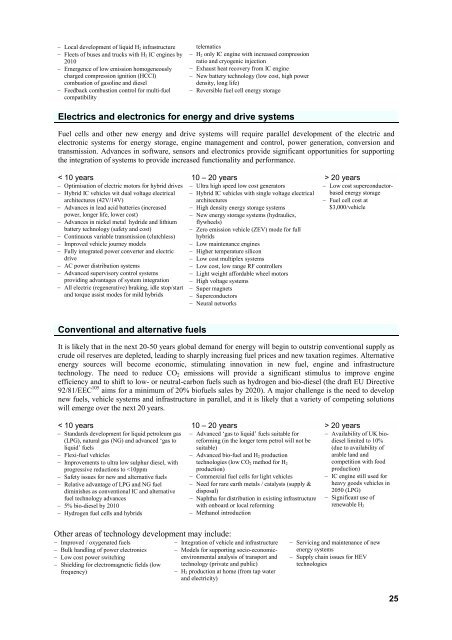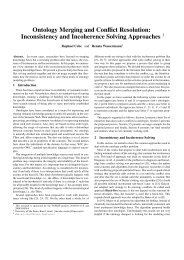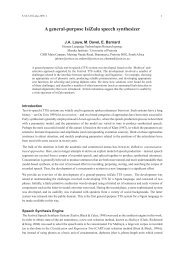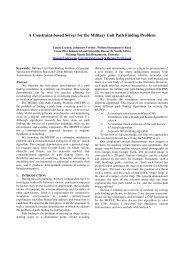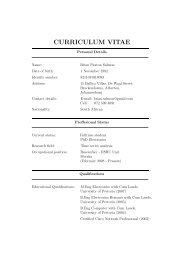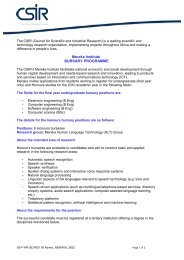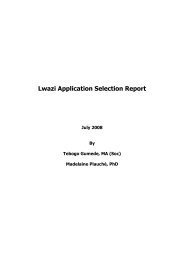Local development of liquid H 2 infrastructure Fleets of buses and trucks with H 2 IC engines by2010 Emergence of low emission homogeneouslycharged compression ignition (HCCI)combustion of gasoline and diesel Feedback combustion control <strong>for</strong> multi-fuelcompatibilitytelematics H 2 only IC engine with increased compressionratio and cryogenic injection Exhaust heat recovery from IC engine New battery technology (low cost, high powerdensity, long life) Reversible fuel cell energy storageElectrics and electronics <strong>for</strong> energy and drive systemsFuel cells and other new energy and drive systems will require parallel development of the electric andelectronic systems <strong>for</strong> energy storage, engine management and control, power generation, conversion andtransmission. Advances in software, sensors and electronics provide significant opportunities <strong>for</strong> supportingthe integration of systems to provide increased functionality and per<strong>for</strong>mance.< 10 years 10 – 20 years > 20 years Optimisation of electric motors <strong>for</strong> hybrid drives Hybrid IC vehicles wit dual voltage electricalarchitectures (42V/14V) Advances in lead acid batteries (increasedpower, longer life, lower cost) Advances in nickel metal hydride and lithiumbattery technology (safety and cost) Continuous variable transmission (clutchless) Improved vehicle journey models Fully integrated power converter and electricdrive AC power distribution systems Advanced supervisory control systemsproviding advantages of system integration All electric (regenerative) braking, idle stop/startand torque assist modes <strong>for</strong> mild hybrids Ultra high speed low cost generators Hybrid IC vehicles with single voltage electricalarchitectures High density energy storage systems New energy storage systems (hydraulics,flywheels) Zero emission vehicle (ZEV) mode <strong>for</strong> fullhybrids Low maintenance engines Higher temperature silicon Low cost multiplex systems Low cost, low range RF controllers Light weight af<strong>for</strong>dable wheel motors High voltage systems Super magnets Superconductors Neural networks Low cost superconductorbasedenergy storage Fuel cell cost at$3,000/vehicleConventional and alternative fuelsIt is likely that in the next 20-50 years global demand <strong>for</strong> energy will begin to outstrip conventional supply ascrude oil reserves are depleted, leading to sharply increasing fuel prices and new taxation regimes. Alternativeenergy sources will become economic, stimulating innovation in new fuel, engine and infrastructuretechnology. The need to reduce CO 2 emissions will provide a significant stimulus to improve engineefficiency and to shift to low- or neutral-carbon fuels such as hydrogen and bio-diesel (the draft EU Directive92/81/EEC 105 aims <strong>for</strong> a minimum of 20% biofuels sales by 2020). A major challenge is the need to developnew fuels, vehicle systems and infrastructure in parallel, and it is likely that a variety of competing solutionswill emerge over the next 20 years.< 10 years 10 – 20 years > 20 years Standards development <strong>for</strong> liquid petroleum gas(LPG), natural gas (NG) and advanced ‘gas toliquid’ fuels Flexi-fuel vehicles Improvements to ultra low sulphur diesel, withprogressive reductions to
Research challengesHybrid electric applications, where an electric motor is used as part of the propulsion system, tosupport the combustion engine or to operate separately <strong>for</strong> specific, limited driving situations. Theapplication of the electric drive can be implemented in many ways and there is a research need <strong>for</strong>improved models (simulations) of the drive system and the driving modes, in order to determinethe optimum system layout and machinery sizes <strong>for</strong> particular applications. This will lessen theexpense of building and operating prototype vehicles. Support systems and components that needto be researched and developed <strong>for</strong> these applications include:Power Battery. To support the combustion engine, especially in acceleration mode or whenthe electric drive is operated alone, the battery needs to be able to deliver high ‘instantaneous’power with minimum weight and cost. It also has to be able to deliver a large number ofpower cycles <strong>for</strong> a good lifetime durability. Challenges include cell engineering, energymanagement systems, low cost materials and design <strong>for</strong> manufacture. Desirable goals (<strong>for</strong>cars) would be storage systems with the following per<strong>for</strong>mance levels: 30kW, 3kWh, 40kg,$450.Electric Motor and Power Electric Inverter. The key feature of the motor is the ability todeliver high power <strong>for</strong> successive acceleration demands with high efficiency and to handle thenecessary cooling requirements. In many hybrid applications the motor will need to be closelyintegrated within the combustion engine or transmission system. Providing the electrical driveto the motor, the power electric inverter has similar demands <strong>for</strong> high power and cooling. Akey element is the research and development of high power, low cost power switching devicesso that, ideally, the same cooling system as that used <strong>for</strong> the combustion engine can be used.Desirable goals are 50kW <strong>for</strong> cars and 150kW <strong>for</strong> commercial vehicles, at a cost of less than$1,000. Challenges include high operating voltages and device specifications, new materials(<strong>for</strong> example SiC), high temperature capacitors, thermal design and management, and costreduction. Advances in the aerospace sector may be useful if they can be transferred toautomotive.Combustion Engine, Exhaust Aftertreatrment and Transmission. In order to make maximumbenefit of the hybrid system <strong>for</strong> per<strong>for</strong>mance, fuel economy and exhaust emission the‘conventional’ power train has to be optimised – in particular to design the system <strong>for</strong> its rolewithout the need to meet high power acceleration demands. In a similar vein the transmissionsystem can be optimised <strong>for</strong> fewer gear changes and to link the gear changing with the electricdrive <strong>for</strong> automated operation. This area of research can also include ‘alternative’ combustionengine systems such as external combustion and gas turbine. Challenges include suitability <strong>for</strong>hybrid duty cycles (stop / start), compatible combustion systems (conventional, bio- and CNG/ H 2 fuels), product engineering <strong>for</strong> customer acceptance (reliability and per<strong>for</strong>mance), andhow to improve efficiency. Example technologies include downsizing and low weight,advanced combustion / feedback control, heat recovery and gaseous fuel handling.Electronic Control of Power Train. The combustion engine and the electric motor are verydifferent in their capabilities and operational uses and yet they need to per<strong>for</strong>m together inharmony <strong>for</strong> optimum efficiency and driving per<strong>for</strong>mance. There is there<strong>for</strong>e the need <strong>for</strong> awhole vehicle drive system electronic control. To optimise efficiency (engine and congestion),ensure smooth and stable per<strong>for</strong>mance, improve ease of use, safety, security and lawen<strong>for</strong>cement, and to reduce emissions. Challenges include multiple system modellingintegration, network design / architecture (control), low cost high power CPV’s, better use ofcommunication links, and improved system compatibility. Example technologies includesystem control / diagnostics, adaptive and intelligent vehicle management systems.Battery electric applications, where the mileage range of battery powered vehicles will alwaystend to be a limitation, not least because of the time to recharge from electrical power outlets. It isexpected, there<strong>for</strong>e, that these vehicles will meet ‘niche’ markets <strong>for</strong> short range and specific fleet/ delivery / public transport applications. Support systems and components that need to be26


